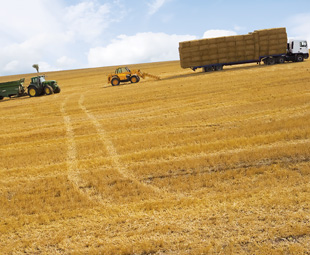Down to earth

UDO RYPSTRA expects that this year’s Nampo Harvest Day will again provide an insight into just how much farmers have come to rely on road transport instead of rail to get their crops to the mills, silos and processing plants – with the threat of bancruptcy just around the corner every time transport costs go up.
Next month, from 17 to 20 May, thousands of people will be descending on Nampo Park, an exhibition ground 15 km outside Bothaville in the Free State, to celebrate Nampo Harvest Day. This event, which was initiated in 1967 as a one-day show by a small group of farmers who founded the National Maize Producers Organisation, has today blossomed into a colourful, four-day extravaganza covering most farming sectors. It is now internationally known as the biggest annual agricultural show in the southern hemisphere.
A distraction is South Africa’s provincial elections on 18 May, but the organisors, Grain South Africa, are confident the show will attract nearly 70 000 visitors overall, if not more, as it did last year. Nampo is South Africa’s premier agricultural show, attended by grain farmers, cattle, sheep, pig and chicken farmers, vegetable and fruit farmers, as well as extension officers and government officials from Southern Africa. In addition, hundreds of staff will be manning over 650 exhibition stands, stalls and open-air displays of any agricultural product or service you can think of – from big harvesters and trucks costing over R1 million apiece, to guns for game hunters and roses for coy Free State ladies.
Then, on 21 May it all comes to an end. For the farmers it will be back to business, facing severe challenges such as growing and transporting over 60 million tons of produce and livestock annually, only to have to deal with escalating fuel prices, a depreciating rand, higher vehicle prices, keeping operating costs down on a national road network with increasing toll fees, or negotiating a secondary road network that has been disintegrating as fast as the truck population swells.
Where are the days when good old Spoornet moved agricultural produce at rates between 20% and 30% cheaper than by road, from mills and silos to processing plants and the cities? This is the question many farmers are asking themselves, especially smaller ones lacking the economies of scale the big agricultural corporates have. Five years ago about 80% of the grain crop was moved by rail, but this has come down to less than 50% with road transport having increased its share drastically as rail branch lines fell into disuse. The new, unsubsidised parastatal Transnet Freight Rail has cut out non-profitable rail services, especially those with empty return legs.
In February 2006, the Department of Agriculture issued a report about the state of agricultural logistics. It criticised the fragmentation of logistic services and the lack of rail capacity for bulk commodities such as grain, as well as high costs, unreliability and for being slow. Even then it recorded concern about rising fuel costs, high toll fees, the lack of alternative routes, lack of qualified drivers, bad roads and long waits at border posts. It came up with a national agricultural logistics strategy to implement it – calling partly on farmers to co-operate with one another, but it was never implemented.
Since then, a National Freight Logistics Strategy has been in the making aimed at moving several heavy bulk commodities, not only agricultural produce, back onto rail. But apart from investing billions in new and refurbished rolling stock for the main lines, Transnet has responded by offering its rail branch network for use in joint ventures with the private sector. However, the cost of restoring branch lines, plus equipment at mills and silos, has been described as prohibitively high.
The governments of Brazil, Argentina, New Zealand and Australia subsidise their farmers indirectly to reduce the cost of infrastructure in order for them to be more competitive on world markets. Indirect allocations like this are also made by the South African government – the 2011 Budget, including provincial allocations, making provision for R19 billion to be spent on rural development and agriculture in 2011/12, rising to R21 billion in 2013/14. An additional R1,5 billion goes to provinces for road maintenance (fixing potholes, too) and weighbridges, as part of a new conditional grant for roads infrastructure.
The Agricultural Business Chamber (ABC) has welcomed the Budget’s emphasis on agriculture, specifically referring to “stepped up support to primary agriculture” and various mentions of rural development programmes and initiatives. “The announcement of support for infrastructure development, research and development, and trade facilitation, is appreciated. These factors are considered by the ABC as amongst the most important towards ensuring an enabling agribusiness environment to succeed and to enhance competitiveness of the sector. The proposed investment in infrastructure development and road maintenance can have a significant effect on decreasing the cost of transport and overall cost of doing business in South Africa.”
Meanwhile, the agricultural logistics industry has, of its own accord, undertaken to reduce road damage and keep transport costs as low as possible. A few years ago, studies conducted by the Road Transport Management System (RTMS), a private intiative led by the forestry sector, indicated that most road damage is caused by overloaded trucks, while trucks that are legally loaded contribute 40% of the damage. RTMS now strives for load optimisation, the wellbeing of drivers, vehicle maintenance and productivity.
In this regard, there will be a lot on show at Bothaville, where no fewer than 15 well-known truck manufacturers and two leading trailer manufacturers will be showing their vehicles, capable of moving up to 40 tons of agricultural commodities per vehicle combination. Commercial vehicles used by the the agricultural sector range from the popular ordinary pick-ups and medium heavy rigid trucks to specialised truck-tractor and trailer combinations. In this regard, South Africa’s farming community displays a strong loyalty to Japanese and European manufacturers of 4×2 and 4×4 pick-ups and double cabs, not only because these manufacturers have been around for many decades, but also because of the dealer and back-up networks they have. Go through any farming town and you’ll find a Mercedes-Benz, Toyota or Isuzu dealer who has gone through the ups and downs of farm life with them.
This mutual loyalty is reflected in the popularity of Japanese and European cars as well as medium heavy, heavy and extra heavy trucks/combinations.
Their loyalty also lies with manufacturers of specialised truck body and trailer designs who understand farmers’ needs. Apart from water tankers, also widely used on the many game farms, these can be specified for milk, wine and fuel, or for truck combinations which cater for the transportation of bulk commodities such as wheat, maize, beans, flour, stockfeed, fertiliser, etc.
While there are a number of manufacturers specialising in small trailers, for example for pigs, cattle, horses and game such as rhino and giraffes, big trailers with payloads of up to 40 tons are the speciality of top trailer manufacturers such as Afrit, SA Truck Bodies, Duncanmec, Kearneys, Flexi Engineering and Top Trailers. These manufacturers are in constant competiton with one another to produce lowbeds (with cranes, if needed), dropsides and highly specialised high-mass trailers such as cattle trailers, sugar cane trailers, forestry loggers, and reefers, or insulated trailers for fresh produce. Flexi Engineering and Top Trailers recently brought out an interlink trailer, able to load milk and grain at the same time, in two tanks with a tipper body for grain in the middle! (See FOCUS February).
While many big corporate farming undertakings will purchase their own fleet or outsource that particular transport function to specialised road transport companies, smaller farmers will make use of load brokers who will use one-man or small fleet operators on an ad hoc basis.
Afrit and SA Truck Bodies/Henred Freuhauf are regular exhibitors at Bothaville. In addition, off-road vehicle manufacturers such as Bell Equipment and suppliers of tractors and harvesters such as John Deere and New Holland, will be present. Needless to say, there will also be scores of manufacturers of materials handling equipment, feeding systems, agricultural machinery, windmills, irrigation equipment, pumps, generators, solar heating, agricultural IT systems and financial services.
All this may sound rather boring to the uninitiated, but there is also plenty of entertainment, which usually includes fashion parades (going beyond khaki), makeup workshops by TV personalities, clothing, delicatessen and curio stalls, to name just a few, and there will be no shortage of food or drinks. Last year the festive crowd went through 6 624 hamburger rolls, 10 104 cocktail buns, 19 440 hotdog buns and 1 600 kg of (uncooked) potato chips. Not mentioned on the Nampo Harvest Day website, though, is that usually several thousand litres of beer, spirits and mixers are also consumed before the tough reality of being a farmer strikes again.
The farming community is facing trying times because, according to ABC economists, every time road transport costs go up – and they will go up steeply this year – some farmers, especially those in remote areas, a long distance away from mills, silos and abattoirs, go out of business.
Published by
Focus on Transport
focusmagsa



